It’s tough to balance the promise of hybrid fuel economy with the power many drivers want to enjoy in a car. It can be even tougher when an automotive brand is known for quick vehicles. That’s what makes the BMW 330e a fascinating car to test.
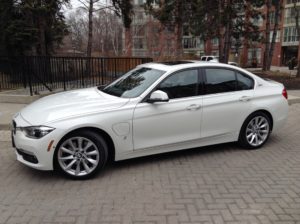
First impressions
I unplugged my Alpina White tester from the charger in BMW’s head office lot, then took a quick look around the car. It’s a modern Bimmer all the way round, from the twin kidneys and narrowed headlights up front right through the sculpted doors and low-profile tires.
The only slight difference was the door covering the charger port on the right just behind the left front wheel well. The more a driver uses that port, the less premium unleaded said driver has to pour into the 330e’s 40-litre tank.
Interior
Black Dakota leather with oyster stitching meshes well with wood accents.
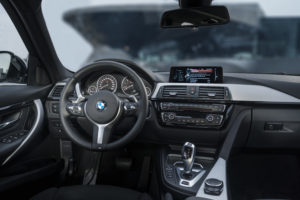
image courtesy BMW
The heated steering wheel complements heated, fully adjustable front seats. I quickly made myself comfortable, quietly thanking BMW for ensuring I need not touch the ceiling of their vehicles with my head.
The rear seats may be a tad restrictive for taller folks, but the rear of the roofline isn’t as rakishly sloped as those of other makes. Thank BMW’s current sedan design language for doing more than most to keep rear seats as spacious as possible.
Hockey bag test
The trunk is shallow thanks to the location of the battery that fuels the electric motor just underneath the trunk floor.
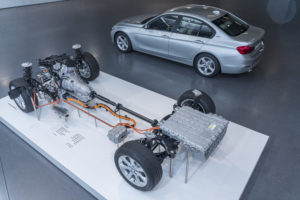
image courtesy BMW
That plus the narrow opening obliged some squeezing and maneuvering to squish the hockey bag into luggage compartment. Sticks went through a section of the fold-down rear seats.
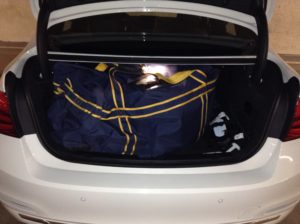
In-cabin technology
A widescreen control display atop the centre stack accommodates BMW’s controller-driven systems.
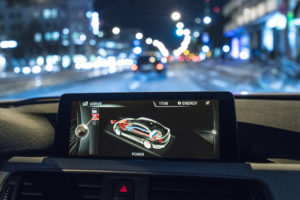
image courtesy BMW
This is not a touchscreen. It’s a little far away for front-seat occupants, unless they have the arms of Inspector Gadget.
Instead, BMW places a rotary controller surrounded by a cluster of buttons just ahead of the centre storage bin. The bin’s padded leather cover serves as an armrest while a front-seat occupant uses said controller and buttons.
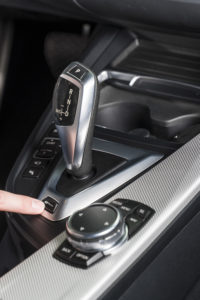
image courtesy BMW
Among all carmaker systems I’ve tried, this controller is one of my favourites. It’s a dial, button, joystick, and touchpad on which the system accepts letters drawn using one’s fingers. This last capability evokes fond memories of Palm Pilots past. (The more I use systems that forego touchscreens, the more convinced I am that they are the way to go.)
Nipping quickly through BMW’s system menus is a breeze. Designers were thoughtful enough to provide a preview of the submenu of a given menu item off to the right so drivers can quickly know whether to go into that menu or not.
The centre storage bin was pretty shallow in my tester. It includes a wireless phone charging “platform” that keeps a phone in place using one fixed and one moveable, spring-loaded holder. This charger is part of BMW’s smartphone connectivity package. Other package components include are Apple CarPlay “preparation” and a WiFi hotspot.
The four-gauge instrument cluster fits neatly inside the “frame” of the steering wheel. There’s a digital screen there too, but when inactive it’s the same shade of black as its surroundings, another subtly enjoyable design touch. Drivers can navigate the screen using buttons on the left (turn signal) stalk on the steering column.
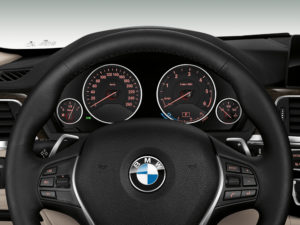
image courtesy BMW
The heads-up display (HUD) is part of BMW’s Premium Package Enhanced.
It shows speed, posted limits (right on most of the time), navigation instructions and entertainment system settings. The driver can determine which of these bits of information appear in the HUD.
As with other such systems I’ve used, it “displays” a bit low for my liking (a couple of inches above the hood), but it’s otherwise sharp, clear and effective. I don’t need to look down at other screens as often with the HUD active.
Oddly, my tester did not ship with adaptive cruise control, a feature I increasingly associate with cars that offer HUDs. It is an option on BMW’s 3-series.
Driving
Step on it and the 330e does not behave like a hybrid. The 4-cylinder, 2-litre engine produces 180 hp and 215 ft lbs of torque. Throw in the electric motor’s oomph and those numbers rise to 248 bhp and 310 ft lbs. The power travels to all four wheels via an 8-speed automatic transmission. The results proved to be what one expects to shoot out of Bavaria – quick and sure-footed acceleration and deceleration on demand. (By the way, thanks BMW for forgoing needless paddle shifters.)
The 330e offers four drive modes: Sport +, Sport, Comfort and Eco Pro.
Eco Pro was the one I mostly worked with, since I wanted to explore the “e” part of this car. In town, I rode the electric motors as much as I could. The electric motors get their juice from lithium ion high-performance batteries (under the trunk floor).
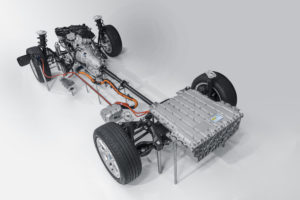
image courtesy BMW
Press the “eDrive” button at the base of the gear lever and look at the main screen. It tells you the car will run off batteries in MAX eDRIVE.
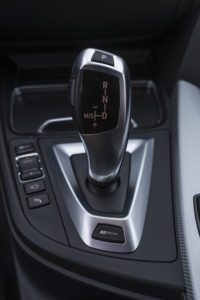
image courtesy BMW
The tachometer stays in the “ready” position while you drive the 330e this way. It’s the same position the tach occupies when running off the gas motor and the car is stopped. A five-bar battery level indicator in the instrument cluster “loses” bars as you drive.
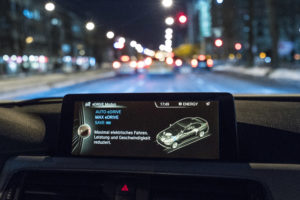
image courtesy BMW
The 330e starts in eDrive and rolls silently on its electric motor until the driver’s demands force the gas engine to contribute. People who drive frequently in urban settings may really enjoy the electric motor, since it makes this Bimmer far less thirsty than it would otherwise be.
BMW claims top speeds with the electric motor of 120 km/h, 210 from the gas motor and 225 combined.
I would have driven more using just the battery, but finding places to charge it can be difficult. There are no charging stations in my condo’s parking garage. None of the parking lots I visited had charging stations. They certainly are spreading, but owners who want to run the 330e on battery power need to check ahead for “outlets.” Otherwise, they had better have outlets in their own garages like this lucky fellow.
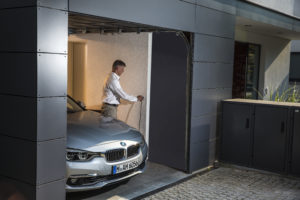
image courtesy BMW
The vehicle can run on its gas engine alone, but benefits like fuel savings and the Departure Time feature may nudge people to keep it plugged in whenever possible.
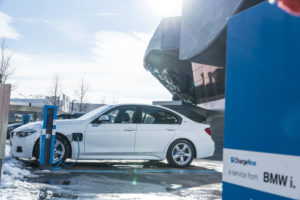
image courtesy BMW
Departure Time is worth checking out. If you know you’re using the 330e at a certain time and enter that time into the 330e’s system, it will warm or cool the vehicle just ahead of the departure time you set. The car is comfortable when you get in, and it uses less fuel to make it so once you get moving.
In typical hybrid behaviour, drivers who coast to a stop and brake for longer stretches tend recharge the battery above the minimum level of charge the 330e maintains. That behaviour helped me quietly creep around a number of parking lots after draining the battery to said minimum.
Depending on the country you drive in, the 330e may engage acoustic pedestrian protection. In other words, the car makes noise when rolling on electricity at low speeds to alert pedestrians to its presence.
Surround View ought to help most drivers park the 330e confidently. It shows the car and the area several feet around it as you move. This still-rare feature isn’t unique to BMW, but I have a prediction: In the same way that rear-view cameras are becoming as ubiquitous as rear-view mirrors, 360-degree views around the vehicle may travel the same road, from expensive add-on to standard equipment.
For now, Surround View is part of the Driver Assistance Package, a $2,400 extra that also includes sunshades rear and side, active blind spot detection and Driving Assistant. This latter feature includes approach control warning and front-end warning with “city braking” function. Driving Assistant, another feature slowly making its way into more cars, may save the bacon of a distracted driver or two, plus the objects they would otherwise collide with.
Fuel economy
The 41-litre tank takes a minimum (what BMW calls “useable fuel quality”) of 89, though BMW recommends 91. BMW’s fuel economy numbers are 8.5 city, 6.9 highway and 7.8 combined (all numbers L/100km).
Pricing
The 2017 BMW 330e sells for a base MSRP of $52,550. My tester, with Premium Package Enhanced, Driver Assistance Package and Smartphone Connectivity Package, goes for $61,250.